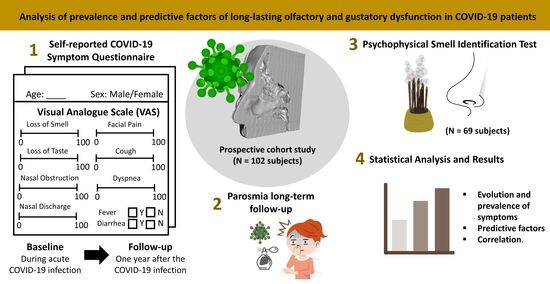Analysis of Prevalence and Predictive Factors of Long-Lasting Olfactory and Gustatory Dysfunction in COVID-19 Patients
Abstract
Share and Cite
Callejón-Leblic, M.A.; Martín-Jiménez, D.I.; Moreno-Luna, R.; Palacios-Garcia, J.M.; Alvarez-Cendrero, M.; Vizcarra-Melgar, J.A.; Fernandez-Velez, C.; Reyes-Tejero, I.M.; Maza-Solano, J.; Gonzalez-Garcia, J.; et al. Analysis of Prevalence and Predictive Factors of Long-Lasting Olfactory and Gustatory Dysfunction in COVID-19 Patients. Life 2022, 12, 1256. https://doi.org/10.3390/life12081256
Callejón-Leblic MA, Martín-Jiménez DI, Moreno-Luna R, Palacios-Garcia JM, Alvarez-Cendrero M, Vizcarra-Melgar JA, Fernandez-Velez C, Reyes-Tejero IM, Maza-Solano J, Gonzalez-Garcia J, et al. Analysis of Prevalence and Predictive Factors of Long-Lasting Olfactory and Gustatory Dysfunction in COVID-19 Patients. Life. 2022; 12(8):1256. https://doi.org/10.3390/life12081256
Chicago/Turabian StyleCallejón-Leblic, María A., Daniel I. Martín-Jiménez, Ramón Moreno-Luna, Jose M. Palacios-Garcia, Marta Alvarez-Cendrero, Julissa A. Vizcarra-Melgar, Carlos Fernandez-Velez, Isabel M. Reyes-Tejero, Juan Maza-Solano, Jaime Gonzalez-Garcia, and et al. 2022. "Analysis of Prevalence and Predictive Factors of Long-Lasting Olfactory and Gustatory Dysfunction in COVID-19 Patients" Life 12, no. 8: 1256. https://doi.org/10.3390/life12081256
APA StyleCallejón-Leblic, M. A., Martín-Jiménez, D. I., Moreno-Luna, R., Palacios-Garcia, J. M., Alvarez-Cendrero, M., Vizcarra-Melgar, J. A., Fernandez-Velez, C., Reyes-Tejero, I. M., Maza-Solano, J., Gonzalez-Garcia, J., Tena-García, B., Acosta-Mosquera, M. E., Del Cuvillo, A., & Sánchez-Gómez, S. (2022). Analysis of Prevalence and Predictive Factors of Long-Lasting Olfactory and Gustatory Dysfunction in COVID-19 Patients. Life, 12(8), 1256. https://doi.org/10.3390/life12081256










